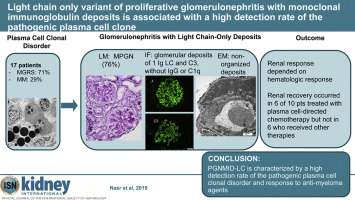当前位置:
X-MOL 学术
›
Kidney Int.
›
论文详情
Our official English website, www.x-mol.net, welcomes your
feedback! (Note: you will need to create a separate account there.)
Light chain only variant of proliferative glomerulonephritis with monoclonal immunoglobulin deposits is associated with a high detection rate of the pathogenic plasma cell clone.
Kidney International ( IF 14.8 ) Pub Date : 2019-11-09 , DOI: 10.1016/j.kint.2019.10.025 Samih H Nasr 1 , Christopher P Larsen 2 , Christophe Sirac 3 , Jason D Theis 1 , Camille Domenger 4 , Sophie Chauvet 5 , Vincent Javaugue 6 , Jonathan J Hogan 7 , Samar M Said 1 , Surendra Dasari 8 , Julie A Vrana 1 , Ellen D McPhail 1 , Lynn D Cornell 1 , Eve Vilaine 9 , Ziad A Massy 9 , Jean-Jacques Boffa 10 , David Buob 11 , Stéphanie Toussaint 12 , Thomas Guincestre 13 , Guy Touchard 4 , Vivette D D'Agati 14 , Nelson Leung 15 , Frank Bridoux 6
Kidney International ( IF 14.8 ) Pub Date : 2019-11-09 , DOI: 10.1016/j.kint.2019.10.025 Samih H Nasr 1 , Christopher P Larsen 2 , Christophe Sirac 3 , Jason D Theis 1 , Camille Domenger 4 , Sophie Chauvet 5 , Vincent Javaugue 6 , Jonathan J Hogan 7 , Samar M Said 1 , Surendra Dasari 8 , Julie A Vrana 1 , Ellen D McPhail 1 , Lynn D Cornell 1 , Eve Vilaine 9 , Ziad A Massy 9 , Jean-Jacques Boffa 10 , David Buob 11 , Stéphanie Toussaint 12 , Thomas Guincestre 13 , Guy Touchard 4 , Vivette D D'Agati 14 , Nelson Leung 15 , Frank Bridoux 6
Affiliation

|
IgG (mainly IgG3) is the most commonly involved isotype in proliferative glomerulonephritis with monoclonal immunoglobulin deposits (PGNMID). Here we describe the first series of PGNMID with deposition of monoclonal immunoglobulin light chain only (PGNMID-light chain). This multicenter cohort of 17 patients presented with nephritic or nephrotic syndrome with underlying hematologic conditions of monoclonal gammopathy of renal significance (71%) or multiple myeloma (29%). Monoclonal immunoglobulin was identified by serum and urine immunofixation in 65% and 73%, respectively, with abnormal serum free light chain in 83%, and a detectable bone marrow plasma cell clone in 88% of patients. Renal biopsy showed a membranoproliferative pattern in most patients. By immunofluorescence, deposits were restricted to glomeruli and composed of restricted light chain (kappa in 71%) and C3, with granular appearance and subendothelial, mesangial and subepithelial distribution by electron microscopy. Proteomic analysis in four cases of kappa PGNMID-light chain revealed spectra for kappa constant and variable domains, without evidence of Ig heavy chains; spectra for proteins of the alternative pathway of complement and terminal complex were detected in three. The classical pathway was not detected in three cases. After median follow up of 70 months, the renal response was dependent on a hematologic response and occurred in six of ten patients treated with plasma cell-directed chemotherapy but none of five patients receiving other therapies. Thus, PGNMID-light chain differs from PGNMID-IgG by higher frequency of a detectable pathogenic plasma cell clone. Hence, proper recognition is crucial as anti-myeloma agents may improve renal prognosis. Activation of an alternative pathway of complement by monoclonal immunoglobulin light chain likely plays a role in its pathogenesis.
中文翻译:

具有单克隆免疫球蛋白沉积物的仅增殖性肾小球肾炎的轻链变体与致病性浆细胞克隆的高检测率相关。
IgG(主要是IgG3)是增生性肾小球肾炎中最常见的同种型,伴有单克隆免疫球蛋白沉积物(PGNMID)。在这里,我们描述了第一个系列的PGNMID,仅沉积了单克隆免疫球蛋白轻链(PGNMID-轻链)。这项多中心队列研究包括17例患有肾病或肾病综合症的患者,这些疾病具有潜在的肾脏显着性单克隆丙种球蛋白病(71%)或多发性骨髓瘤(29%)的血液学状况。通过血清和尿液免疫固定分别鉴定出65%和73%的单克隆免疫球蛋白,异常游离血清轻链的占83%,可检测到的骨髓浆细胞克隆的患病率为88%。肾活检在大多数患者中表现为膜增生型。通过免疫荧光,沉积物仅限于肾小球,由受限制的轻链(κ含量为71%)和C3组成,通过电子显微镜观察,颗粒外观和内皮下,肾小球膜和上皮下分布。蛋白质组学分析的4例κPGNMID轻链案例揭示了κ恒定域和可变域的光谱,没有Ig重链的迹象。补体和末端复合物交替途径的蛋白质的光谱在三个中被检测到。在三例中未检测到经典途径。中位随访70个月后,肾脏反应取决于血液学反应,在接受浆细胞定向化学疗法治疗的10例患者中有6例发生了肾脏反应,但接受其他疗法的5例患者中没有一个发生。因此,PGNMID轻链与PGNMID-IgG的不同之处在于可检出的病原性浆细胞克隆的频率更高。因此,正确识别是至关重要的,因为抗骨髓瘤药物可以改善肾脏预后。单克隆免疫球蛋白轻链激活补体的替代途径可能在其发病机理中起作用。
更新日期:2019-11-11
中文翻译:

具有单克隆免疫球蛋白沉积物的仅增殖性肾小球肾炎的轻链变体与致病性浆细胞克隆的高检测率相关。
IgG(主要是IgG3)是增生性肾小球肾炎中最常见的同种型,伴有单克隆免疫球蛋白沉积物(PGNMID)。在这里,我们描述了第一个系列的PGNMID,仅沉积了单克隆免疫球蛋白轻链(PGNMID-轻链)。这项多中心队列研究包括17例患有肾病或肾病综合症的患者,这些疾病具有潜在的肾脏显着性单克隆丙种球蛋白病(71%)或多发性骨髓瘤(29%)的血液学状况。通过血清和尿液免疫固定分别鉴定出65%和73%的单克隆免疫球蛋白,异常游离血清轻链的占83%,可检测到的骨髓浆细胞克隆的患病率为88%。肾活检在大多数患者中表现为膜增生型。通过免疫荧光,沉积物仅限于肾小球,由受限制的轻链(κ含量为71%)和C3组成,通过电子显微镜观察,颗粒外观和内皮下,肾小球膜和上皮下分布。蛋白质组学分析的4例κPGNMID轻链案例揭示了κ恒定域和可变域的光谱,没有Ig重链的迹象。补体和末端复合物交替途径的蛋白质的光谱在三个中被检测到。在三例中未检测到经典途径。中位随访70个月后,肾脏反应取决于血液学反应,在接受浆细胞定向化学疗法治疗的10例患者中有6例发生了肾脏反应,但接受其他疗法的5例患者中没有一个发生。因此,PGNMID轻链与PGNMID-IgG的不同之处在于可检出的病原性浆细胞克隆的频率更高。因此,正确识别是至关重要的,因为抗骨髓瘤药物可以改善肾脏预后。单克隆免疫球蛋白轻链激活补体的替代途径可能在其发病机理中起作用。











































 京公网安备 11010802027423号
京公网安备 11010802027423号